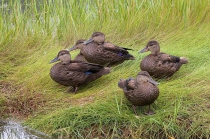
| Introduction | | Search taxa | | Taxon tree | | Taxon match | | Checklist | | Literature | | Stats | | Photogallery | | OBIS Vocab | | Log in |
WoRMS taxon detailsAnas rubripes Brewster, 1902
159170 (urn:lsid:marinespecies.org:taxname:159170)
accepted
Species
Anas obscura · unaccepted
Not documented
Distribution Caribbean, North America; range extends from Northern Labrador to southern North Carolina
Distribution Caribbean, North America; range extends from Northern Labrador to southern North Carolina [details] Taxonomy Most common duck in New Brunswick
Taxonomy Most common duck in New Brunswick [details]
WoRMS (2025). Anas rubripes Brewster, 1902. Accessed at: https://www.marinespecies.org/aphia.php?p=taxdetails&id=159170 on 2025-05-04
Nomenclaturebasis of record
Banks, R.C., R.W. McDiarmid, and A.L. Gardner. 1987. Checklist of vertebrates of the United States, the U.S. Territories, and Canada. U.S. Fish and Wildlife Service Resource Publication No. 166. 79 p. [details] Othercontext source (Bermuda)
Amos, E. J. R. (1991). A Guide to The Birds of Bermuda. 206 pp [details]
additional source Robbins, C. S. (1983). Golden field Guide to Birds of North America. Golden press. 360p. [details] additional source Linkletter, L. E. (1977). A checklist of marine fauna and flora of the Bay of Fundy. <em>Huntsman Marine Laboratory, St. Andrews, N.B.</em> 68: p. [details] additional source Peterson, R.T.; Peterson, V.M. (2002). A field guide to the birds of eastern and central North America. <em>Fifth Edition.</em> Peterson Field Guide Series. Houghton Mifflin Company. New York. 427 p. [details] additional source Squires, H. J. (1990). Decapod Crustacea of the Atlantic coast of Canada. <em>Canadian Bulletin of Fisheries and Aquatic Sciences.</em> 221: 532 p., available online at http://www.dfo-mpo.gc.ca/library/116743.pdf [details] additional source Animal Diversity Web. <em>University of Michigan Museum of Zoology.</em> , available online at http://animaldiversity.ummz.umich.edu/site/index.html [details] additional source Vanner, M. (2003). The encyclopedia of North American birds. <em>Paragon Publishing.</em> 1-383. [details] additional source Gallardo, J. C.; Macías, V.; Velarde, E. (2009). Birds (Vertebrata: Aves) of the Gulf of Mexico. <em>In: Felder, D.L. and D.K. Camp (eds.), Gulf of Mexico–Origins, Waters, and Biota. Biodiversity. Texas A&M Press, College Station, Texas.</em> Pp. 1321–1342. [details] additional source Integrated Taxonomic Information System (ITIS). , available online at http://www.itis.gov [details]  Present Present  Present in aphia/obis/gbif/idigbio Present in aphia/obis/gbif/idigbio  Inaccurate Inaccurate  Introduced: alien Introduced: alien  Containing type locality Containing type locality
Unreviewed
Diet seeds and vegetative parts of aquatic plants and crop plants, invertebrates (insects, molluscs, crustaceans) [details]Dimensions Length: 23" (58 cm) [details] Distribution Caribbean, North America; range extends from Northern Labrador to southern North Carolina [details] Habitat bays, estuaries, marches, lagoons, and lakes [details] Importance game species [details] Predators man [details] Reproduction Breeds from Labrador to northern Manitoba and south to North Carolina, Ohio, and North Dakota. Winters from Newfoundland and southern Ontariosouth to Florida and Texas. Most nests are on the ground but a few are found in trees every year. Eggs are laid middle March to late June. [details] Taxonomy Most common duck in New Brunswick [details]
|

